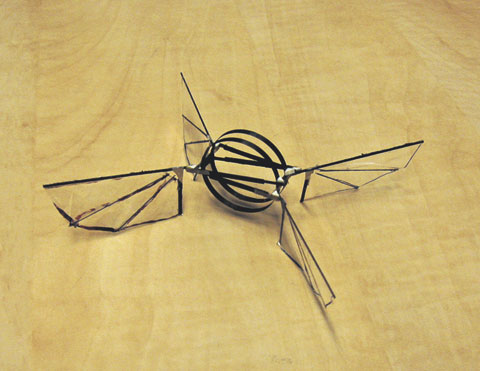A butterfly flaps its wings and flies around; a moth is attracted to a bright light; a bee descends upon a flower to satiate its thirst. Now imagine a bug-sized, self-sustaining micro air vehicle that can flap, change direction and attain flight.
In spite of the great advances in aerial technology, nature still leads in flight techniques. Animal flight has always been a fascination in the scientific community and inspiration for the Atalanta project comes from flying insects: the name Atalanta comes from the butterfly species Vanessa atalanta.
Assistant professor Hans Goosen of TU Delft’s precision and microsystems engineering section (3mE) explains that the goal of the project, which started in November 2005, is to design a mechatronic flying device which can fly in different environments, such as an office, house or vehicle. The whole bug is to be completely self-sustaining in terms of energy management and navigation. A similar venture is the Delfly project at the faculty of Aerospace Engineering, with the goal being to miniaturize their larger model using a top-down approach. This poses some problems, especially when it comes to energy loss and weight. Hence, the Atalanta project decided to start from scratch and go ground-up, starting their development from a much smaller scale. The mass of the Atalanta bug is around 0.7g. Because of this, the energy losses are kept to a minimum.
The project was initiated by DevLab, which is a cooperative of twelve companies in Eindhoven. None of the companies is actually interested in the final outcome of the flying bug, rather the key goal is to have an understanding of the techniques, research and implementations required for the design. The biggest challenge is making everything integrated. This includes the sensors, micro-actuators, power systems, control, mechanics, navigation and communication systems. The team also aims to recreate the swarming behavior of certain insects.
The bug is a completely compliant mechanism that can bend and move upon actuation and is fully resonant. This means that at certain frequencies, even very small driving forces can produce large amplitude oscillations. There are absolutely no gears or hinges involved in the design. The wing frames are also made of flexible compliant material and they can flap and move in different directions. The flapping behavior of the four wings is complex and, again, the inspiration for their design comes from insects. Changes in the configuration of the wings result in changes in resonance—this is one of the challenging aspects of the project. The resonance state is perturbed by actuation and this reduces the energy required to generate lift. Around 0.6 g of lift is produced, which is a considerable amount, but it is not enough to lift the actuator itself. Development of a different form of energy storage for further weight reduction is in the works and one of the ideas is to use chemical energy for actuation.
The goal of the Atalanta project is to design a mechatronic flying device that can fly in different environments, such as an office, house or vehicle. The whole bug is to be completely self-sustaining in terms of energy management and navigation and the biggest challenge is making everything integrated, such as the sensors, micro-actuators, power systems, control, mechanics, navigation and communication systems. The bug is a completely compliant mechanism, which can bend and move upon actuation and is fully resonant. There are absolutely no gears or hinges involved in the design. The mass of the Atalanta bug is just around 0.7g.
Caspar Bolsman is the PhD researcher working on the Atalanta project under the supervision of Hans Goosen. For more information or to get involved, assistant professor Hans Goosen would be delighted to hear from you at j.f.l.goosen@tudelft.nl
Dat blijkt uit een peiling van onderzoeksbureau Newcom Research & Consultancy en het weekblad VKbanen onder docenten en ondersteunend personeel. Aan de peiling namen 825 mensen deel. Zij beoordeelden de kwaliteit van het onderwijs met een gemiddeld rapportcijfer van 5,9.
Kritisch
Dat cijfer is relatief laag. In een eerder onderzoek van het onderzoekbureau naar de tevredenheid van werknemers in het bedrijfsleven, bleken de ondervraagden meer tevreden. Volgens onderzoeker Ivo Duchateau kan komen doordat docenten meer dan gemiddeld kritisch zijn.
Tamelijk tevreden over de onderwijskwaliteit zijn werknemers in het basisonderwijs. Zij gaven een 6,4. Werknemers in het mbo zijn met een cijfer van 5,3 minder tevreden. Werknemers in het voortgezet onderwijs zitten daar met een gemiddelde van 5,9 tussenin.
Kennisniveau
Mbo-medewerkers beoordelen het kennisniveau van leerlingen, op het moment dat zij aan de opleiding beginnen, met een gemiddelde van 4,3. Ook over de aansluiting van verschillende onderwijstypen – zoals van vmbo op mbo – zijn ze niet tevreden. Die krijgt een 4,8.
Werkdruk en management
Uit het onderzoek blijkt verder dat in het onderwijs de werkdruk te hoog is en de beloning te laag. Opvallend is de kritiek op het management en de structuur van de onderwijsinstelling.
Bijna de helft van de ondervraagden acht de organisatie niet in staat om werknemers te motiveren. Een kwart meent dat hij niet integer wordt behandeld en 36 procent vindt dat het management niet kundig is. “De directie heeft alleen oog voor winst maken en heeft geen affiniteit met het echte onderwijs”, aldus één van de respondenten. Volgens hem heeft de docent te weinig invloed op de school als organisatie.
Andere baan
De meerderheid van de ondervraagden wil ondanks de matige score nu geen andere baan. Wel denkt 22 procent het onderwijs binnen vijf jaar te verlaten. Ruim 80 procent voelt zich veilig op school, al ervaart meer dan een kwart stress als gevolg van ‘de veranderende jongerencultuur’. Over de gevolgen van de economische crisis maakt slechts zes procent van de ondervraagden zich zorgen.



Comments are closed.